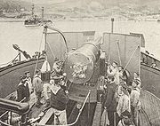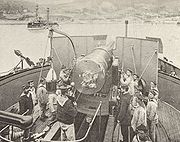
Barbette
Encyclopedia


Cannon
A cannon is any piece of artillery that uses gunpowder or other usually explosive-based propellents to launch a projectile. Cannon vary in caliber, range, mobility, rate of fire, angle of fire, and firepower; different forms of cannon combine and balance these attributes in varying degrees,...
or heavy artillery
Artillery
Originally applied to any group of infantry primarily armed with projectile weapons, artillery has over time become limited in meaning to refer only to those engines of war that operate by projection of munitions far beyond the range of effect of personal weapons...
gun. The name comes from the French
French language
French is a Romance language spoken as a first language in France, the Romandy region in Switzerland, Wallonia and Brussels in Belgium, Monaco, the regions of Quebec and Acadia in Canada, and by various communities elsewhere. Second-language speakers of French are distributed throughout many parts...
phrase en barbette referring to the practice of firing a field gun
Field gun
A field gun is an artillery piece. Originally the term referred to smaller guns that could accompany a field army on the march and when in combat could be moved about the battlefield in response to changing circumstances, as to opposed guns installed in a fort, or to siege cannon or mortars which...
over a parapet
Parapet
A parapet is a wall-like barrier at the edge of a roof, terrace, balcony or other structure. Where extending above a roof, it may simply be the portion of an exterior wall that continues above the line of the roof surface, or may be a continuation of a vertical feature beneath the roof such as a...
(defensive wall) rather than through an opening (embrasure
Embrasure
In military architecture, an embrasure is the opening in a crenellation or battlement between the two raised solid portions or merlons, sometimes called a crenel or crenelle...
). The former gives better angles of fire but less protection. For example, the Confederate defenders at the Second Battle of Fort McAllister were unable to operate their cannons because the en barbette gun emplacements provided poor protection from Union riflemen outside the fort.
Before the complete introduction of the fully enclosed armoured gun turret
Gun turret
A gun turret is a weapon mount that protects the crew or mechanism of a projectile-firing weapon and at the same time lets the weapon be aimed and fired in many directions.The turret is also a rotating weapon platform...
s, a barbette was a fixed armoured enclosure protecting the gun. The barbette could take the form of a ring of armour around the gun mount over which the guns (possibly fitted with a gun shield) fired.
In warships from the age of the dreadnought
Dreadnought
The dreadnought was the predominant type of 20th-century battleship. The first of the kind, the Royal Navy's had such an impact when launched in 1906 that similar battleships built after her were referred to as "dreadnoughts", and earlier battleships became known as pre-dreadnoughts...
forward, the barbette is the non-rotating drum beneath the rotating gun turret (properly known as the "gunhouse") and above the armoured deck
Deck (ship)
A deck is a permanent covering over a compartment or a hull of a ship. On a boat or ship, the primary deck is the horizontal structure which forms the 'roof' for the hull, which both strengthens the hull and serves as the primary working surface...
on a warship. It forms the protection for the upper ends of the hoists that lift shells
Shell (projectile)
A shell is a payload-carrying projectile, which, as opposed to shot, contains an explosive or other filling, though modern usage sometimes includes large solid projectiles properly termed shot . Solid shot may contain a pyrotechnic compound if a tracer or spotting charge is used...
and their propelling charges (e.g. cordite
Cordite
Cordite is a family of smokeless propellants developed and produced in the United Kingdom from 1889 to replace gunpowder as a military propellant. Like gunpowder, cordite is classified as a low explosive because of its slow burning rates and consequently low brisance...
) from the magazines below.
When applied to military aircraft, largely in aviation history books written in British English
British English
British English, or English , is the broad term used to distinguish the forms of the English language used in the United Kingdom from forms used elsewhere...
, a barbette is a position on an aircraft
Aircraft
An aircraft is a vehicle that is able to fly by gaining support from the air, or, in general, the atmosphere of a planet. An aircraft counters the force of gravity by using either static lift or by using the dynamic lift of an airfoil, or in a few cases the downward thrust from jet engines.Although...
where a gun, or guns, are in a mounting which has a restricted arc of fire when compared to a turret, or which is remotely mounted away from the gunner. As such it is frequently used to describe the tail gunner
Tail gunner
A tail gunner or rear gunner is a crewman on a military aircraft who functions as a gunner defending against enemy fighter attacks from the rear, or "tail", of the plane. The tail gunner operates a flexible machine gun emplacement on either the top or tail end of the aircraft with a generally...
position on bombers such as the B-17 Flying Fortress, with American English aviation books usually describing this position as a "flexible" gun mount, when the term "turret" itself is not used.
The term "barbette" (again, mostly as a convention of British English
British English
British English, or English , is the broad term used to distinguish the forms of the English language used in the United Kingdom from forms used elsewhere...
) can be used to describe military aircraft of World War II with a remotely aimed and operated gun turret. The German Messerschmitt Me 210
Messerschmitt Me 210
The Messerschmitt Me 210 was a German heavy fighter and ground-attack aircraft of World War II. The Me 210 was designed to replace the Bf 110 in heavy fighter role; design started before the opening of World War II. The first examples of the Me 210 were ready in 1939, but they proved to have poor...
and Me 410 Hornisse had FDSL (Fernbedienbare Drehseitenlafette) 131 twin remote turrets - one per side - for rearward defense. The Germans used the generic term "lafette" for describing these remotely controlled weapons, and indeed for almost any movable defensive gun mount in German World War II-era aircraft.
See also
- Disappearing gunDisappearing gunA disappearing gun is a type of heavy artillery for which the gun carriage enabled the gun to rotate backwards and down into a pit protected by a wall or a bunker after it was fired...
, an intermediate step between barbettes and gun turrets - Gun turretGun turretA gun turret is a weapon mount that protects the crew or mechanism of a projectile-firing weapon and at the same time lets the weapon be aimed and fired in many directions.The turret is also a rotating weapon platform...

